20 Best Evergreen Trees for Privacy and Year-Round Greenery
These evergreen trees are easy to grow as a living privacy screen and a great source of year-round greenery.
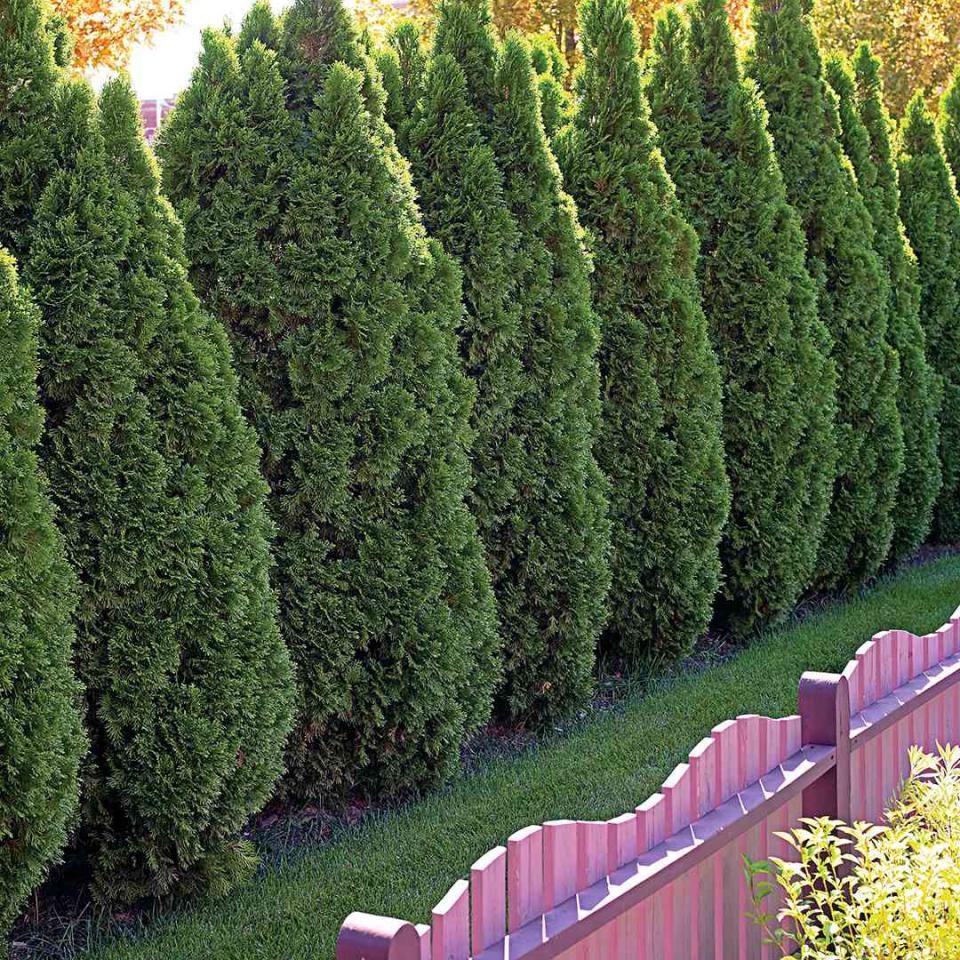
Reviewed by Sylvia Duax
Planting evergreen trees as privacy screens often looks friendlier than a fence, is cheaper than a wall, and prettier than lattice. It may take longer to reach a size to fully do the job, but it will likely outlast any of these other options for creating privacy and look better, too. Here are 20 of the best types of evergreen trees to plant for screening, offering a range of leaf colors, textures, and adaptability to various growing conditions.
What Are Evergreen Trees?
Evergreen trees are woody plants that keep their leaves or needles year-round rather than dropping them for winter like deciduous trees do.
Douglas Fir
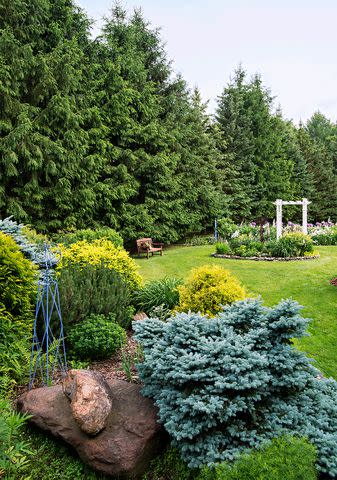
For the noble, spirelike shape that evergreen lovers admire so much, plant douglas fir (Pseudotsuga menziesii). Though it's often featured as a lone tree, it also looks great massed as a screen in evergreen landscaping. Douglas fir doesn't like hot, dry winds but will do excellent where there's moisture in the soil and in the air. The soft-textured tree has variable color, depending on seed source, with the blue-green types being the most attractive and hardy.
Growing Conditions: Full sun in consistently moist, well-drained soil
Size: Up to 80 feet tall
Zones: 5-7
Eastern Red Cedar
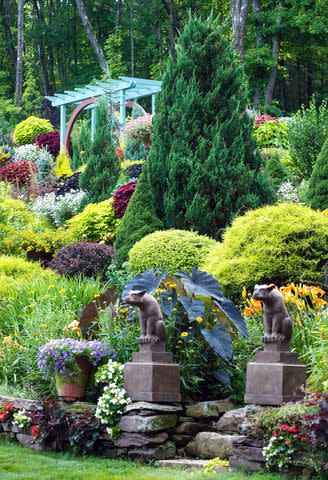
So adaptable you'll find it growing on dry, rocky slopes and at the edges of swamps, eastern red cedars (Juniperus virginiana) also thrive as urban screens and rural windbreaks. This densely branched juniper has rich green summer foliage turning ruddy brown-green in winter.
Growing Conditions: Full sun in well-drained soil
Size: Up to 50 feet tall
Zones: 2-9
White Pine
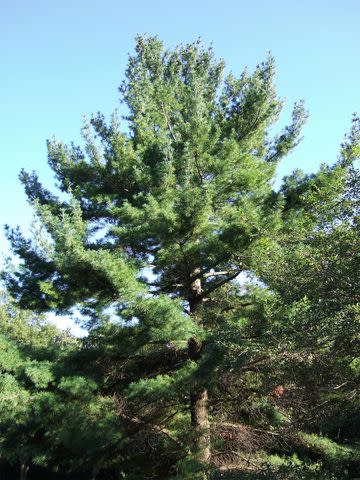
Some varieties of white pine (Pinus strobus) can grow 50 to 80 feet tall and 20 to 40 feet wide, so this evergreen needs plenty of room. But for smaller yards, you can also find columnar varieties that max out at 20 feet in height and 14 feet in width, a perfect size for screens. White pine is a fast-growing tree with soft, billowy texture that's a welcome departure from the rigid look of many other evergreens. The blue-green needles are attractive year-round, and a portion of them drop to the ground periodically, so the trees are self-mulching.
Growing Conditions: Full sun to part shade in well-drained soil
Size: Up to 80 feet tall
Zones: 3-8
Concolor Fir
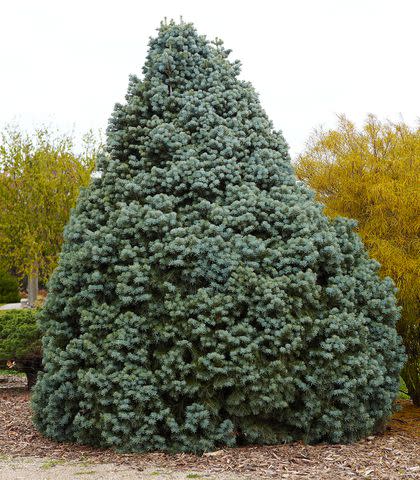
Like white pine, concolor fir (Abies concolor) can adapt to a variety of growing conditions. Also known as white fir, it's a good choice for hot, dry conditions and winter cold, but it grows best with an evenly moist soil that has good drainage. The blue-gray needles have a white luster, which explains the common name. In addition to its unique needles, concolor fir has an attractive conical shape with tiered branches, so it works as a specimen to block a view or partnered with other trees in evergreen landscaping.
Growing Conditions: Full sun to part shade in well-drained soil
Size: Up to 70 feet tall
Zones: 3-7
Norway Spruce
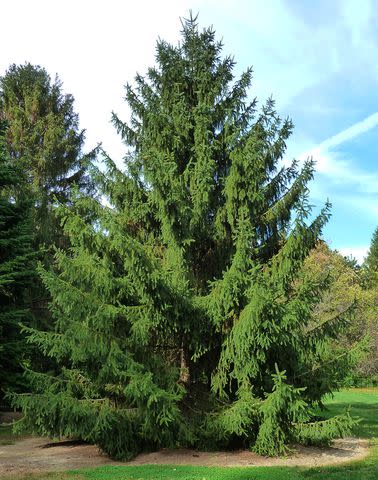
Easy to spot among other evergreens, Norway spruce (Picea abies) has the pyramidal shape typical of many conifers, but the horizontal branches reach upward, allowing the stems to hang down gracefully. The effect is both beautiful and distinctive. Norway spruce grows 50 to 60 feet tall and 25 to 30 feet wide, but popular varieties tend to be on the smaller side.
Growing Conditions: Full sun in well-drained soil
Size: Up to 60 feet tall
Zones: 2-7
Deodar Cedar
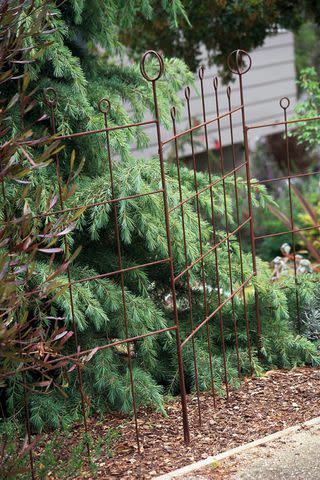
One of the only true cedars, deodar cedar (Cedrus deodara) is very adaptable, grows fast, and has dense branching in youth. It's perfect for a screen or as part of evergreen landscaping, but it also makes a striking solo tree with blue-green needles and graceful, gently weeping branches that become more artistic with age.
Growing Conditions: Full sun in well-drained soil
Size: Up to 50 feet tall
Zones: 7-8
False Cypress
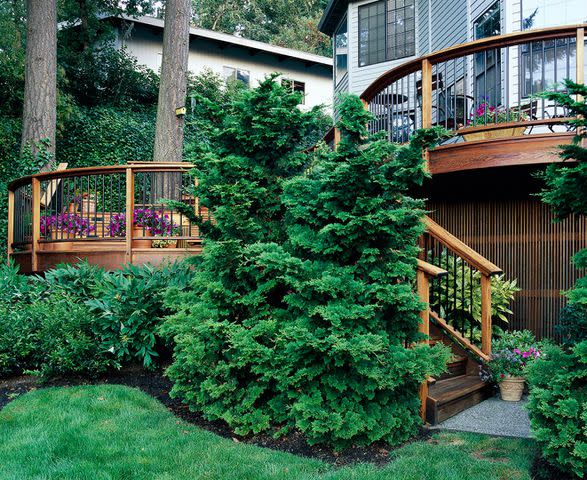
A valuable addition to your winter garden, false cypress (Chamaecyparis spp.) has plenty of varieties with different shapes and colors. Not surprisingly, it's also wonderful for adding privacy. Some false cypress cultivars can be trimmed like a hedge; others can be allowed to reach their fluffy, twisted, or contorted potential. Colors range from blue-gray to golden-green.
Growing Conditions: Full sun to part shade in well-drained soil
Size: Up to 75 feet tall
Zones: 4-8
Related: The 10 Best Hedge Trimmers for Perfectly Manicured Shrubs
Leyland Cypress
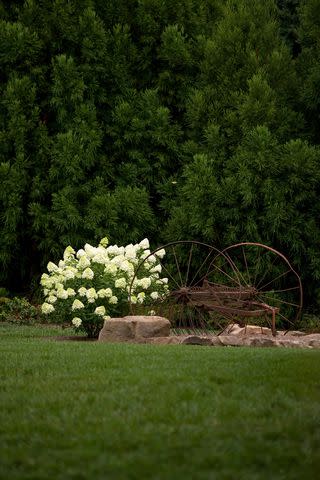
Another warm-climate evergreen tree for privacy, leyland cypress (Cupressus x leylandii) is a natural for screening hedges, thanks to its columnar shape and year-round color. If the feathery, blue-green foliage doesn't grab you, there are cultivars with yellow, gray, or bright green foliage.
Growing Conditions: Full sun to part shade in consistently moist, well-drained soil
Size: Up to 70 feet tall
Zones: 6-9
American Arborvitae
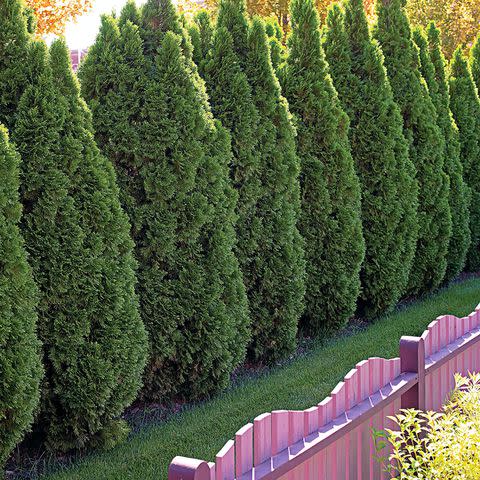
The go-to evergreen for lining a fence, American arborvitae (Thuja occidentalis), also known as eastern arborvitae, can live for several hundred years. Most popular varieties mature at 10 to 15 feet, much smaller than in the wild, making them perfect for year-round privacy in evergreen landscaping. American arborvitae is durable and adaptable, but its biggest problem is deer browsing (wrap arborvitae in burlap in the winter or spray with a deer repellent to ward off deer).
Growing Conditions: Full sun to part shade in consistently moist soil
Size: Up to 70 feet tall
Zones: 2-7
Yew
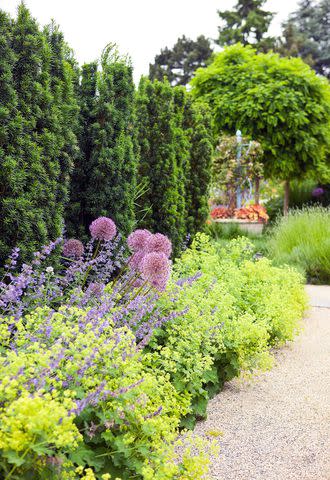
The tree of immortality, some ancient specimens of yew (Taxus spp.) have lived for thousands of years. In evergreen landscaping, yews are often used as hedges and foundation plantings. The dark green foliage and colorful red berries are a welcome sight in winter, and birds love the shelter of yews, too.
Growing Conditions: Full sun to part shade in well-drained or dry soil (yews can't tolerate soggy soil)
Size: Up to 50 feet tall
Zones: 4-7
Yews can be poisonous to humans and lethal to animals so it's best to avoid planting them if you have small children or pets/livestock around.
American Holly
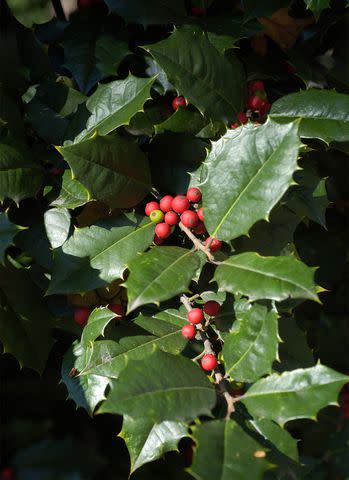
A native evergreen that provides food and shelter for a variety of pollinators and other wildlife, American holly (Ilex opaca) has a loose conical habit. It’s beloved for its bright red or orange berries in fall and is prized for its deer resistance. Plant both male and female cultivars to ensure berry production. Winter protection is important in Zones 5 and 6; plant American holly in a location that is protected from winter wind.
Growing Conditions: Full sun and moist, well-drained soil. Provide afternoon shade in Zones 8 and 9.
Size: Up to 60 feet tall
Zones: 5–9
Italian Cypress
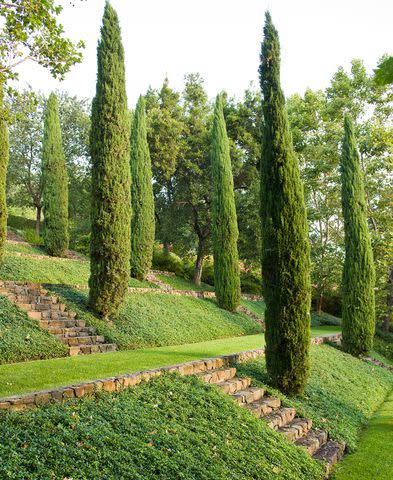
Native to dry, mountainous locations in Europe and Asia, Italian cypress (Cupressus sempervirens) has good drought tolerance when it is established but requires regular watering for the first year or so after planting. Italian cypress is prized for its fast growth as a young plant and strongly upright habit—no pruning needed. These tall and stately evergreen shrubs most often function like exclamation points in the landscape. Group several of them together to create a lofty hedge.
Growing Conditions: Full sun and well-drained soil
Size: 40 feet or more
Zones: 7–10
Chinese Juniper
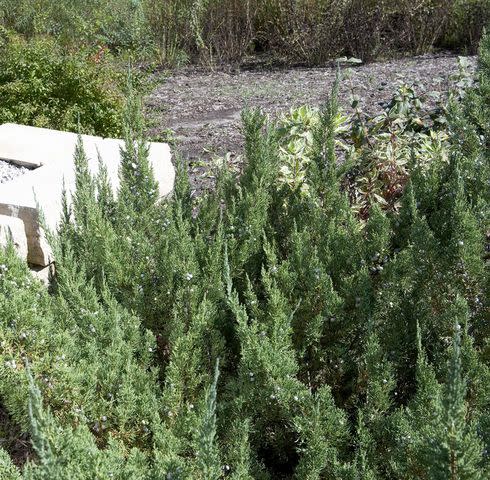
A slow-growing evergreen shrub with prickly needles, Chinese juniper (Juniperus chinensis) is an excellent plant for a barrier hedge. Plant it where you want to deter humans and animals from traveling. Its dense green or blue-green branches form a loose pyramidal shape. Chinese juniper does best in full sun but will tolerate part shade, where it tends to develop a loose, open habit. There are many varieties of Chinese juniper; choose an upright variety to create a hedge.
Growing Conditions: Full sun and well-drained soil
Size: 50 feet tall
Zones: 4–9
Blue Spruce
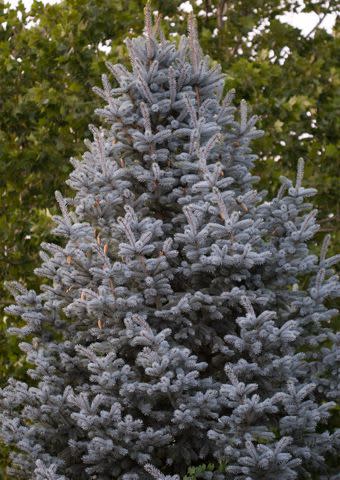
Grown for the dusty blue hue of its needles, blue spruce (Picea pungens) stands out when planted alongside green-needled evergreens. Plant it with Black Hills spruce and white pine for a striking privacy screen. Blue spruce is native to the central Rocky Mountains where cool temperatures and well-drained soil prevail. It doesn’t tolerate heat and humidity well. Keep young plants consistently moist until they are established. It becomes more drought tolerant after establishes a strong root system.
Growing Conditions: Full sun and well-drained soil
Size: 30 to 60 feet
Zones: 2–7
Bay Laurel
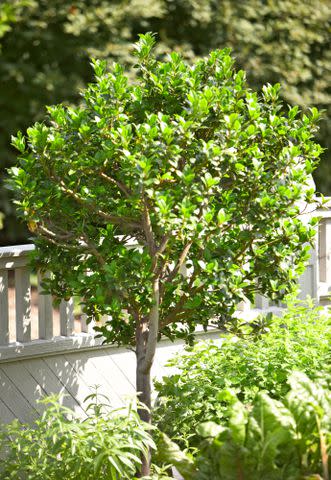
Dean Schoeppner
The leathery leaves of this large evergreen shrub can be harvested, dried, and used to flavor savory dishes. Sometimes called sweet bay, bay laurel (Laurus nobilis) has a dense growth habit and loose, rounded structure that makes it a welcome contrast to strongly upright evergreen shrubs. Plant several slow-growing bay laurel shrubs together to create a dense hedge.
Growing Conditions: Full sun or part shade and well-drained soil
Size: 8 to 12 feet tall and wide
Zones: 8–10
Black Hills Spruce
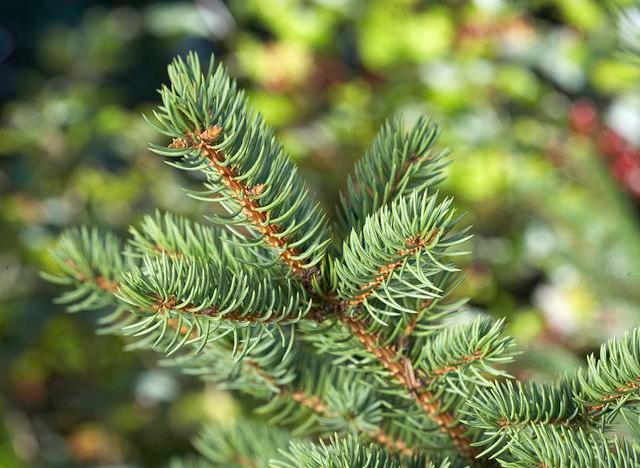
Dean Schoeppner
An evergreen with short needles, Black Hills spruce (Picea glauca 'Densata') grows best in cool climates. It is a popular type of Christmas tree and has the classic pyramidal holiday tree shape. Perfect for a windbreak, this evergreen tree has dense, full branching and good wind resistance. It does grow slowly but a mature Black Hills spruce is worth the wait.
Growing Conditions: Full sun and well-drained soil.
Size: 35 to 45 feet tall
Zones: 2-6
Japanese Cedar
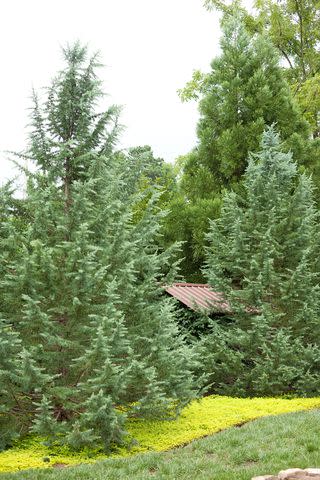
A needled evergreen with a soft, fine texture, Japanese cedar (Cryptomeria japonica) is a great alternative to Leyland cypress. Pyramidal and mounding cultivars offer a variety of forms for use as a hedge or in a mixed screen of evergreen shrubs. Look for a dwarf variety for smaller landscapes.
Growing Conditions: Full sun or part shade and moist, well-drained soil
Size: 40 feet tall
Zones: 5–9
Southern Wax Myrtle
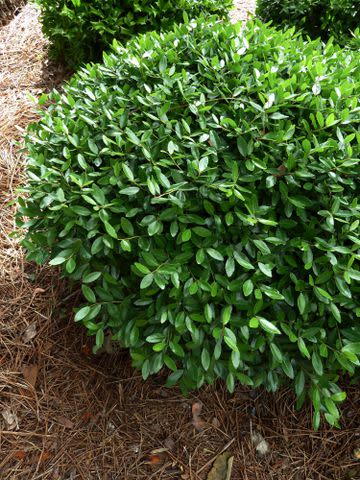
Denny Schrock
Tolerant of a wide range of growing conditions and a favorite nectar source for pollinators, Southern wax myrtle (Morella cerifera) is a multi-stemmed tree or large shrub. Its broad olive-green leaves are glossy and fragrant when crushed. Plant three to five plants together to create a living screen in a small space.
Growing Conditions: Full sun to part shade and average to wet soil
Size: Up to 20 feet tall
Zones: 7–10
Japanese Holly
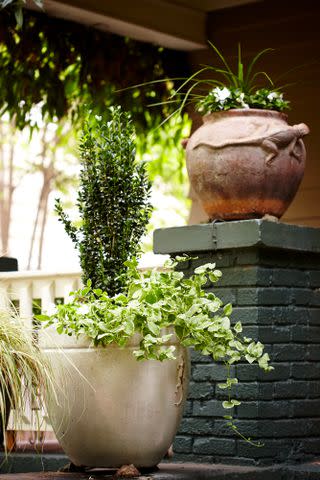
Brie Williams
If you’re looking for an evergreen to shear into a formal shape, Japanese holly (Ilex crenata) might be a good fit. Tolerant of severe pruning and popular for creating topiaries, Japanese holly has small, deep green leaves and dense branching. It is a slow-growing shrub. Native to thickets and wetlands in Japan, Japanese holly adapts to many soil types but grows best in moist soil and cool climates. It doesn’t grow well in the high heat and humidity of Zones 8.
Growing Conditions: Full sun or part shade and moist, well-drained soil
Size: 5 to 10 feet tall
Zones: 5–8
Western Red Cedar
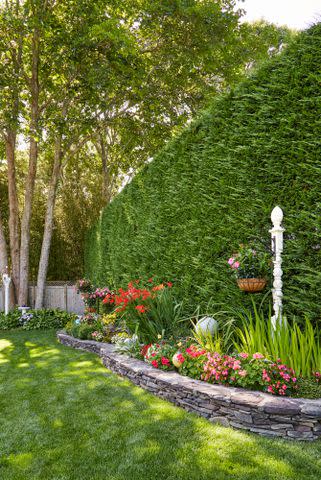
Kritsada Panichgul
A pyramidal tree with soft, scale-like leaves, western red cedar (Thuja plicata) is also called giant western arborvitae; it's native to Alaska and the Pacific Northwest. It's a fast-growing tree and thrives in cooler climates. Its drooping branches with graceful, upturned ends, give it an attractive, relaxed appearance when planted as a screen. Use a western cedar hedge like this one as a backdrop for colorful flowers.
Growing Conditions: Full sun or part shade and moist, well-drained soil
Size: Up to 50 feet tall; many dwarf varieties available
Zones: 5–7
Frequently Asked Questions
Which evergreen trees grow the fastest?
Among the fastest growing evergreen trees are Leyland cypress, which can grow 2-3 feet in a year, and 'Green Giant' arborvitae, with a growth rate of 3-5 feet per year.
Which evergreen trees are the easiest to grow?
The easiest evergreen trees to grow are those that are native to your climate and planted in their preferred conditions.
For more Better Homes & Gardens news, make sure to sign up for our newsletter!
Read the original article on Better Homes & Gardens.

